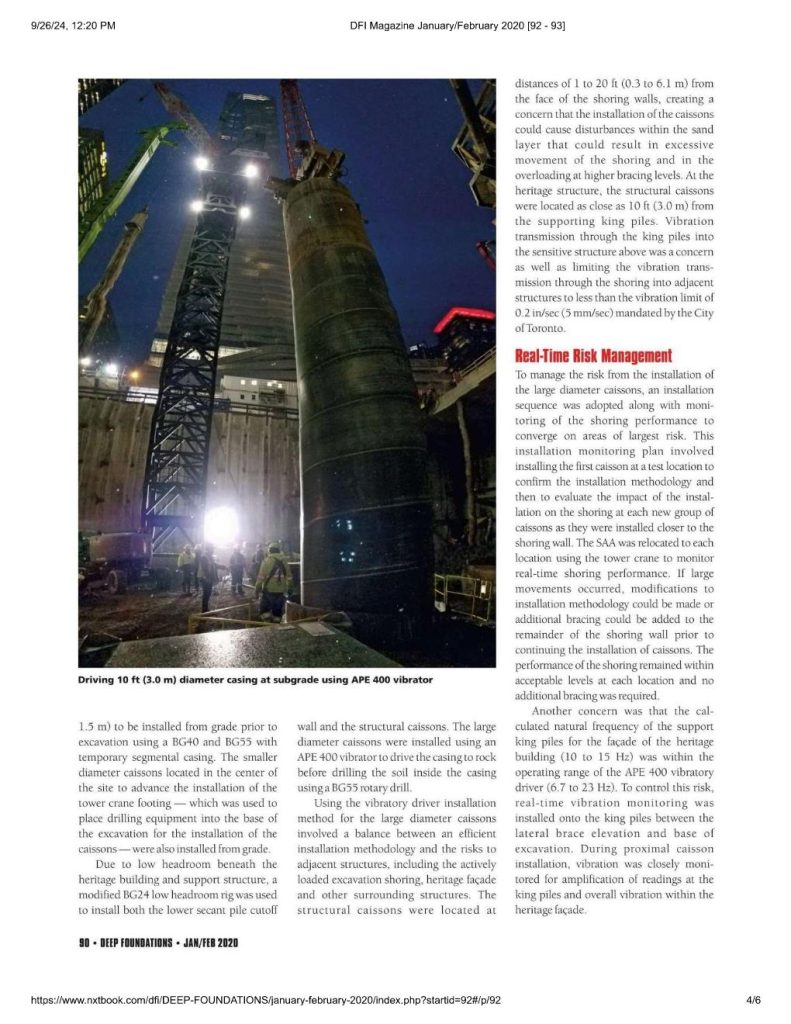Technical Papers:
Performance Based Design: Why Aren’t We Leveraging it to its Full Potential? Managing Opportunity, Safety, and Contract Risk
Deep Foundations Institute, 49th Annual Conference on Deep Foundations · Aurora, CO – October 2024
Authors: Shawna Munn, Dave Wiley, Katie Castelo
The Observational Method is fundamental to the art of subsurface engineering, yet contract methods for effectively leveraging it to its full potential remain limited. This paper demonstrates the advantages of performance based design, with case histories from the past 50 years to illustrate the economic and risk management benefits from leveraging performance based design methologies safety and effectively. The paper describes the risk that specification driven design parameters can have on design economy, constructability, and schedule, and outlines proposed tendering approaches for incorporating performance based designs into contracts, while limiting risk for owners and contractors.
Performance Based Excavation Support Design for Challenging Urban Site Geometry in Toronto, Canada
Deep Foundations Institute, 47th Annual Conference on Deep Foundations · National Harbor, MD – October 2022
Authors: Erika Acton; Shawna Munn; Carol Domitric
This paper covers two major challenges encountered when designing and constructing the EQ Bank Tower in Toronto, which included an 18m deep excavation surrounded by a historical façade. The innovative and adaptable solutions carried out using performance-based design leveraging the observational method include installation of a shoring system in a 500mm gap between the historical façade and a live gas main as well as excavating 10m into expansive shale bedrock adjacent to a sensitive neighbouring building.
Innovations and Challenges During Urban Development – Shoring and Foundations of Canada’s Tallest Residential Structure
Proceedings of the 44th Annual Conference on Deep Foundations, 2019, Chicago, IL, USA · October 2019
Authors: Shawna Munn; Nadir Ansari; Toben Jerry
With ever increasing demands on space in urban environments and smaller available footprints, buildings are being designed to increasing heights to meet the need. This case study discusses the increasing challenges in developing projects within urban environments with smaller available footprints and increasing building heights. The One, Canada’s tallest residential building under construction will stand at 85 storeys and is located at one of the most prominent and built up intersections in Toronto, Yonge Street and Bloor Street. This led to many challenges in design and construction of the shoring and foundation work, including the required design capacity of the foundations for the supertall building and proximity of the large diameter drilled shafts to the excavation shoring wall. This case history describes the shoring design option evaluation, performance, and lessons learned to date throughout construction of the building foundations within a small congested site.
Design recommendations for fibreglass reinforced tunnel softeyes
Proceedings of the WTC 2019 ITA-AITES World Tunnel Congress (WTC 2019), May 3-9, 2019, Naples, Italy · May 2019
Authors: Shawna Munn; Jakub Hudler; Matthew Alexander
This paper outlines the design challenges and recommendations for use of fibreglass reinforcement in tunnel headwall softeyes as learned through transit construction projects in the Greater Toronto Area (GTA). Tunnel boring machines were used to construct underground transit tunnels requiring the design of shafts with softeyes to facilitate tunneling operations. Variable ground conditions and shaft geometries lead to innovative headwall and tunnel softeye design applications using fibre reinforced polymer (FRP) elements (beams, reinforcing bars, and anchors). This paper outlines the challenges and benefits associated with designing and constructing shafts using various FRP systems including lessons learned throughout design and construction of over 20 structures through the past decade.
Tunnel Headwall Softeyes: Fiberglass Design Applications and Constructability Challenges
Proceedings of the 43rd Annual Conference on Deep Foundations · October 2018
Authors: Shawna Munn; Jakub Hudler
This paper outlines the use of tunneling headwall softeyes for transit construction projects in the Greater Toronto Area (GTA) over the past decade. Due to spatial constraints, tunnel boring machines were used to construct the underground tunnels requiring the design of launch and exit shafts with headwall softeyes to facilitate tunneling operations. Variable ground conditions and shaft geometries lead to the development of innovative headwall and tunnel softeye design applications using fiber reinforced polymer (FRP) elements (beams, reinforcing bars, and tiebacks). This paper outlines the challenges and benefits associated with designing and constructing shafts using various systems. Lessons learned throughout design and construction of more than 20 structures over the past 10 years are outlined. The constructability challenges with using FRP and design performance are also discussed.
Prescriptive Specification Design: The Impact on Cost and Constructability – Case History
Deep Foundations Institute, 42nd Annual Conference on Deep Foundations · Oct 25, 2017
Authors: Shawna Munn; Nadir Ansari; Allison Bennett
This paper outlines how specification driven design has made Toronto Area transit infrastructure projects more expensive than similar private projects, and provides a case study of the results of an excavation at Launch Shaft 1 (LS1) for the Eglinton Crosstown Light Rail Transit project in Toronto, Ontario. The paper will describe the impact specification driven design parameters can have on design economy, constructability, and schedule and will suggest an alternative approach utilizing the Observational Method. As a result of the initial specification based design, Isherwood was retained by both the General Contractor and the Specialty Excavation Shoring Contractor to provide value engineering leveraging the Observational Method to improve constructability and construction schedule. By using well known, accepted design methods coupled with local experience in lieu of the specified design pressures and parameters, the redesigned bracing scheme reduced construction cost and schedule. This excavation case history can be a lesson learned for future transit projects.
Technical Articles:
Possibilities and Perils of Fiberglass Anchored Earth Retention
ADSC Foundation Drilling Magazine – July 2023
https://www.adscfoundationdrilling.com/Foundation-Drilling-July-2023/28









Eglinton Crosstown – Over and Under the Existing Subway
An Outstanding Project Award Runner Up
Deep Foundations Magazine – Jan/Feb 2023
https://www.nxtbook.com/dfi/DEEP-FOUNDATIONS/january-february-2023/index.php?startid=2#/p/70





Shoring and Foundations at the One – Canada’s First Supertall Building
Deep Foundations Magazine – Jan/Feb 2020
https://www.nxtbook.com/dfi/DEEP-FOUNDATIONS/january-february-2020/index.php?startid=5#/p/86





